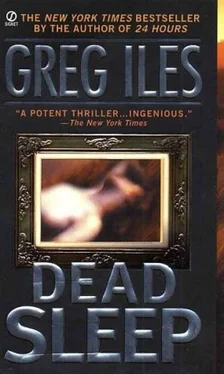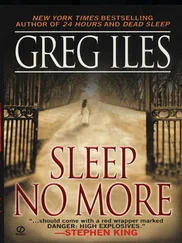“What about the girl?” says Kaiser. “What’s her story?”
“Waste of time,” Lenz says. “There’s no precedent for a woman committing this type of murder.”
“We don’t know they are murders,” Kaiser says with restrained anger. “Until we find some bodies – even one definite – we don’t know what we’re dealing with. I’m not ruling out anybody based on standard profiling techniques. Look at Roger Wheaton. The guy is well over our age limit, but based on what I’ve heard, I have questions.”
“Thalia Laveau,” says Baxter, trying to tamp down the flaring tempers. “Born on Bayou Terrebonne in 1961. Father a trapper, mother a housewife.”
“What did he trap?” asks Kaiser.
“Anything that didn’t trap him first,” I answer.
Bowles belly-laughs again.
“You know about these people?” Baxter asks.
“We did a couple of stories down there when I was on the Times-Picayune. Troubles in the shrimp industry. It’s another world down there. The whole place smells like drying shrimp. You never forget it.”
“Chime in with anything relevant.” Baxter squints down at a file. “Racially, Laveau is part French, part African-American, and part Native American.”
“A redbone?” asks Bowles.
“No, that’s different,” I tell him.
“What’s a redbone?” asks Kaiser. “Like Leon Redbone?”
“Redbones are part black, part Indian,” I reply. “They’re settled all over western Louisiana and East Texas. Thalia Laveau is what’s called a Sabine.”
“That’s not right,” says Baxter, misunderstanding my pronunciation.
“Yes, it is. In Lafourche and Terrebonne Parishes they say ‘Sob-een,’ not Say-been or Say-bine, like the ones you learned about in Roman history. I have no idea why, that’s just the way it is.”
“That girl didn’t look black to me,” says Bowles.
“Or Indian,” says Kaiser, who grew up in the West. “Put her picture back up.”
“Let’s have Laveau, Tom,” says Baxter.
In the next photo – this one color – Thalia Laveau is not merely attractive but beautiful. Her eyes and hair are so black and shiny they seem to float off the screen, while her skin has the look of buttermilk.
“You’re the expert,” Baxter says to me. “Tell us about these people.”
“The Sabines are trappers and fishermen,” I answer, thinking back. “Shrimpers. They live in shacks along bayous that lead to the Gulf of Mexico. They’re not Cajuns, but at her age she would have grown up speaking French. They used to have to be taught English at school. They’re Catholic, but they have strange superstitions. There’s some voodoo in there, I think. Inbreeding, too. They range from white-skinned like this woman to very dark. They can have kinky hair, or straight like hers. They’re tough people, but they love to dance and play music. They’re clannish. Not likely to go to the authorities over trouble. In the eighties they had problems with Vietnamese refugees coming into their shrimping grounds to compete. There were shootings and boat-rammings. It was big news.”
“That’s more than I have here,” says Baxter. “As far as we know, Thalia Laveau had no formal training as an artist. She just started drawing one day and showed a knack for it. Eventually she moved on to painting, mostly watercolors of the bayous and the Gulf. She quit school in the tenth grade and at seventeen went to New York.”
“Just like Wheaton,” I say quietly.
“Yes. And like Wheaton, she had no early success. She supported herself in various ways, from waitressing to working in art galleries. A female art professor thought she heard Laveau say something about stripping for money in New York, but later decided she’d misunderstood. Laveau has worked as a model for a graduate painting class at Tulane, and some of that is nude work. The most significant thing we’ve heard so far is that she’s a lesbian.”
“Is that rumor or fact?” I ask.
“Unconfirmed. We didn’t want to question students at this point. We’d like these people to be totally unprepared at their interviews tomorrow.”
“What does Laveau paint?” asks Kaiser. “Nude women?”
“No. She goes into the homes of strangers, lives there for a while, then starts painting their lives.”
“Like the documentary photographers of the sixties,” I think aloud. “Gordon Parks.”
“All her paintings are finished at one sitting,” Baxter goes on. “She’s attracted a lot of print media attention, but her work doesn’t sell for much. Not remotely in the class of Wheaton or Frank Smith.”
“How much?” asks Kaiser. “A thousand bucks apiece?”
“Ahh… Seven hundred is the highest sum paid to date.”
“Do Leon Gaines’s pictures sell?” I ask.
“Somebody paid five thousand for one. He could make a living at it, if he wasn’t so deep in debt. He’s borrowed to the hilt on student loans, and he owes bookies as well. One former cellmate said he picked up a serious heroin habit in prison.”
“I get the feeling Laveau and Gaines live pretty close to the bone,” says Kaiser. “So where are the millions earned from the Sleeping Women?”
“Good question.”
Dr. Lenz says, “Right now I like Wheaton or Frank Smith. They’re already wealthy, so they would have the knowledge to hide the money, or know people with that knowledge. Gaines is a violent, self-absorbed punk. The attempted rape is an indicator, but he’s too obvious. Too coarse for the crimes we’re dealing with. And Laveau… is a woman.”
“I’m not excluding anybody,” says Kaiser. “After visiting Cayman, I’m convinced Marcel de Becque could be behind it all. He could easily be commissioning someone to paint the pictures and paying them peanuts compared to the overall take. That includes Thalia Laveau or a skell like Gaines.”
“If de Becque is behind this,” Lenz counters, “why draw attention to himself by demanding that we send Glass to see him in exchange for photos of his paintings?”
“He’s a ballsy guy. He’s not scared of us.”
“Not one bit,” I confirm. “But what about Thalia Laveau? What would be her motive? Do you really think a woman’s going to paint dead women for money?”
“I haven’t talked to her yet,” says Kaiser. “So I don’t know. But the kind of people you described – Sabines – they tend to stay where they grow up, right?”
“Yes.”
“So why did she leave? Was she a brilliant kid with ambition? Or was she running from something?” Kaiser looks at Baxter without waiting for an answer. “How are we going to handle the approach? Who’s going in?”
Baxter walks to the wall and switches on the overhead lights. Lenz blinks against the brightness, but he looks set for battle.
“John,” says Baxter, “I know you’ve been point man on this thing for a long time, and against your own wishes, which counts for a lot in my-”
“Damn it,” Kaiser mutters.
Baxter implores Kaiser with his hands. “Listen, John. Because of Wheaton’s artistic stature, and because of his medical condition, I’m inclined to let Arthur take the lead on this one. He has a broad knowledge of art, and he’ll be able to question Wheaton intelligently on his disease, gauge his mental state related to it, and…”
Kaiser sits in silence as Baxter drones on. The decision has been made, and the medical angle makes argument pointless.
“Normally, I would be going in as well,” Baxter concludes. “But because I think you should be there, John, I’m going to send you in in my place. If you feel that some path is being left unexplored, you can go down it. You’ll be there. Okay? It’s just that Arthur will take the lead on the questions.”
Читать дальше
Конец ознакомительного отрывка
Купить книгу












